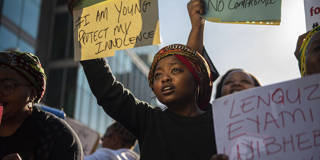Modern development strategies often recognize the pivotal importance of enabling women to fulfill their potential and contribute effectively to their economies. Yet they fail to recognize the need for concerted action to protect women from violence, and uphold the rights of victims. They are thus grossly inadequate.
JOHANNESBURG – The single highest barrier to development globally is neither hunger nor disease. It is gender-based discrimination and violence. That is why achieving United Nations Sustainable Development Goal 5 – gender equality and empowerment of all women and girls – is a prerequisite for progress on the other 16 SDGs. And yet, with only a decade left to complete the SDG agenda, governments continually fail to uphold girls and women’s most basic rights, let alone empower them to reach their full potential.

JOHANNESBURG – The single highest barrier to development globally is neither hunger nor disease. It is gender-based discrimination and violence. That is why achieving United Nations Sustainable Development Goal 5 – gender equality and empowerment of all women and girls – is a prerequisite for progress on the other 16 SDGs. And yet, with only a decade left to complete the SDG agenda, governments continually fail to uphold girls and women’s most basic rights, let alone empower them to reach their full potential.